National Poetry Month: Guest Post from Calef Brown: The How and Why of Wordplay
Happy Poetry Month!
I’d like to talk a little bit about the “how” and the “why” of my poetry.
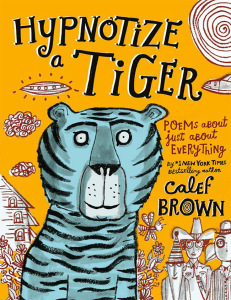
Henry Holt and Co., March 2015.
I come from a family that has always loved wordplay – my parents, siblings, nieces and nephews, and grandparents. We all love music as well, and for me, growing up, that tie to the musicality of language was part of what inspired me to write. My father loved poetry – he studied with Pulitzer prize winning poet Robert Coffin in college and would frequently recite poetry from memory. When I was very young I vividly remember my mother reciting bits of nonsense – one of my favorites being:
Algy met a bear.
The bear met Algy.
The bear was bulgy.
The bulge was Algy.
The playfully dark edge to that poem is something I’ve always loved, and that aesthetic has stayed with me.
I also clearly remember my older brother reading Beatrix Potter’s Two Bad Mice to me when I was 5 or 6 , and just hearing the name “Hunca Munca” repeated made me laugh so hard that on one occasion I literally peed my pants.
That particular reaction to a funny bit of language hasn’t happened since, although, as they say, never say never.
I have become known for writing humorous verse, but not all of my poems are meant to be ha-ha funny. Some are absurd, surreal, quizzical, or evocative and atmospheric. My poem Orchids, for example is about discovering hidden beauty.
Orchids
Orchids are awesome.
Incredibly so.
They steadily grow,
deep in the forest
where the tourists
and the florists
never go.
The idea that words can be elastic, musical, and communicate beyond their literal meaning is something that I loved as a kid, and am still enthralled by today.
I have a poem called Oilcloth Tablecloth that was inspired by overhearing someone at a flea market asking a vendor if they had any of the aforementioned items. Those words – two syllable-three syllable, a little backbeat – just stuck in my head . Later on they became the root of a poem. If a genie ever grants me three wishes, one of them might be to hear Tom Waits read this one:
Oilcloth Tablecloth
Oilcloth Tablecloth
keeps the table dry,
despite the many soda spills
and coffee gone awry.
If someone sloshes orange juice
or baby starts to cry,
Oilcloth Tablecloth
keeps the table dry.
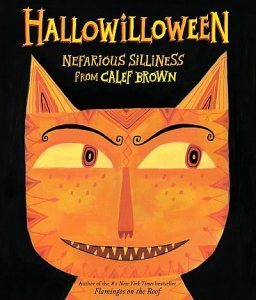
HMH Books for Young Readers, September 2010.
I love the process of building a poem, to me it’s like searching for, and collecting, the pieces to a puzzle that keeps shifting and changing as you go about assembling it.
A poem from my collection HALLOWILLOWEEN titled The Vumpire began with simply noting the similarity between the words vampire and umpire, then finding and following connections. Are there words and concepts that link these two characters? Well, of course there’s the bat, and bats often shatter in pro ball creating shards that wooden stake-phobic vampires would not be pleased with. There’s the dugout , and graves are dug out. A vampire, it would seem, would enjoy a nap there during the seventh inning stretch. Baseball has night games, and so on….
The Vumpire
He only works night games.
His signals are creepy.
When managers argue,
he makes them feel sleepy.
He never appears
in the photos we snap.
A widow’s peak peeks out
from under his cap
when he takes a nap
in the dugout.
His eyes bug out
and he hisses like a frightened cat
at the sight of a broken bat.
How weird is that?
Once, while waiting on deck,
I caught him staring
at the back of the catcher’s neck.
Weatherbee’s Diner was inspired by my mother’s fondness for using the expression “cook up a storm”, especially around the holidays. So I made lists of all the wonderful terms for weather phenomena and looked for relationships to food. Creating lists and word maps is one of the ways that helps me take a germ of an idea into something more.
Weatherbee’s Diner
Whenever you’re looking for something to eat,
Weatherbee’s Diner is just down the street.
Start off your meal with a bottle of rain.
Fog on the glass is imported from Maine.
The thunder is wonderful, order it loud,
with sun-dried tornado on top of a cloud.
Hurricane Curry is also a treat.
It’s loaded with lightning and slathered in sleet.
Cyclones with hailstones are great for dessert,
but have only one or your belly will hurt.
Regardless of whether it’s chilly or warm,
at Weatherbee’s Diner they cook up a storm!
Here are few examples of poems and their origins from my new book HYPNOTIZE A TIGER: Poems About Just About Everything:
Somewhere in my daily reading/internet time-wasting I came across a reference to a Kodiak Bear. I saw the word “Kodak” in there, and that lead to the poem Camera Bear:
Camera Bear
Very shy, and extremely rare,
the Massachusetts Camera Bear
stays aware of the local area
through landscape photography.
It shoots the hillsides,
charts the topography,
then posts pictures on a blog–
shots of the cranberry bog,
the best log for back scratching,
and where to find picnickers
(mainly for snack snatching).
Speaking of time-wasting, while channel surfing in a hotel room (the only place I tend to watch lots of TV) I heard the snippet “an ice road trucker” which sounds the same as “ a nice road trucker”, but is pretty much the opposite, so….
A Nice Road Trucker
I’m a Nice Road Trucker.
My handle is Wayne.
My favorite route to travel
is a country lane.
Turnpikes and traffic
are bad for the brain.
Me and a freeway?
Never the twain.
Scenery is key for me–
it keeps me sane.
Driving over mountains
in a misty rain.
Find me out in Cali
or the coast of Maine.
I’m a Nice Road Trucker.
My handle is Wayne.
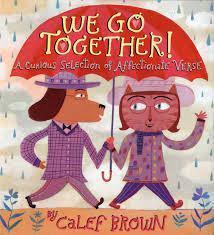
HMH Books for Young Readers, January 2013.
Most of the time, however, the ideas come from my back-and-forth writing and drawing process. Really, my main strategy is just to try to be mindful and curious. To stay aware of sounds and sights around me in my daily life, and write and draw in my sketchbooks as much as I can. Sometimes a poem begins with a drawing, often of a character, and then I start to write a poem about that person or creature. Other times I will do some free associative writing in a sketchbook for a set period of time, put as much down as I can, then later go back to it in a different frame of mind and look for ideas, places to start.
This one, in the Schoolishness chapter of HYPNOTIZE A TIGER, began with two words – “grim creatures” that popped up in some free-associative writing. I noted that it rhymed with “gym teachers” and was off to the races…
The Gym Teachers
They do not, ordinarily,
have pointy teeth of enormous size
and scary greenish eyes,
so my classmates and I
were rather surprised
by the ghoulish faces and glum features.
Something is wrong with the gym teachers!
They crouch in the bleachers
like sneaker-clad sand fleas.
Their whistles are deafening–
louder than banshees
on a noise spree.
Here’s what annoys me:
They make us do battle
In long games of “dodgebull.”
(With actual cattle – a giant garage full!)
Do we look like matadors?!
To them, it doesn’t matter, of course,
having been possessed, I would guess,
by some sort of beast-nest,
or a throng of Brothers Grimm creatures.
Something is wrong with the gym teachers!
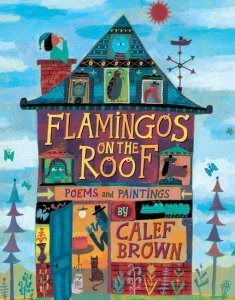
HMH Books for Young Readers, April 2006.
In writing poems that will hopefully spark kids imaginations and inspire creativity, I try to stick with subject matter that they can relate to. Food. Family. Creatures – from monsters to insects to family pets. School, Friendship, Play. As I mentioned before, I’m known for humor and nonsense, but most of the time I don’t necessarily set out to create a poem that will be funny. Yes, in the course of writing, I do crack myself up from time to time, and once in a while it’s to the point of manic giggling (which usually stops abruptly when I realize that my family downstairs probably can hear me) but once I have the germ of an idea I get pulled into the activity of creating the perfect expression of it, with not one unnecessary word or even syllable. Craft is extremely important to me. It’s a pleasurable but challenging process of problem solving, that, since my poems are meant to be read aloud, is not unlike creating a song.
So, as I’m writing a poem I’ll also speak it, and sometimes sing it (if no one is around). I often have the speech function of my computer read my poems in-progress just to hear them in a voice other than my own – even if it’s a robotic one.
I also try to build inspiration and opportunities for inspiring wordplay into my illustrations. There’s a poem called Ten-Cent Haiku in my book FLAMINGOS ON THE ROOF:
Ten-Cent Haiku
I sat down to write a haiku.
It seemed like the right thing to do.
I wouldn’t need very much time.
No need to bother
with making it rhyme.
I reached in my pocket
and pulled out a dime.
This is my ten-cent haiku:
Shiny silver friend.
I will never let you go.
Look! An ice cream truck!
In the background of the illustration, on a lawn in a park, there’s a dog who is sitting with rapt attention focused on a tennis ball, echoing the man who is contemplating the dime in his hand and composing his haiku. When I recite this one, and show the illustration during school visits, I ask the kids to think of a haiku that the dog might be dreaming up as an homage to the ball– his beloved plaything. Here is my favorite of the haikus created by students in response to that prompt:
I want that great ball.
Someone give me that great ball.
I needs my slobber.
There is a chapter of poems that contain portmanteaus in my new book and I’m looking forward to integrating them into both my school presentations and workshops. Perhaps students can make portmanteaus with more than two words –three, four, five, then incorporate them into a poem. Maybe draw them. What other ways could they create links, and combine words, or pictures or ideas?
Over the years, I have visited many schools, and drawn so much inspiration from the enthusiasm and creative energy of the students.
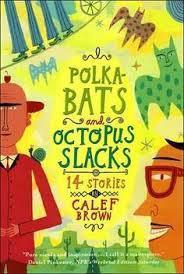
HMH Books for Young Readers, March 1998.
I’ve also learned a lot from the ways kids react – or don’t– to specific poems and illustrations. I am always surprised and delighted too, by the questions they ask, and their incredibly creative ideas and writing that come out of workshops and classroom visits. I enjoy working with a range of grade-levels –from kindergarten up to fifth and sixth . It’s challenging to craft presentations and workshops that are appropriate for different ages, but I feel I have poems and books to draw from that cover that range well. I’m especially looking forward to bringing my new book to middle-grade students, it’s my first created with that audience especially in mind.
There are so many special moments from school trips that I will never forget. During a visit to a school in Portland, a teacher told me about a particular first-grader who was really struggling – especially with reading and issues around self-esteem. After I did a presentation, the students went back to their classrooms and did an exercise which stems from a book I illustrated called Greece! Rome! Monsters!.
During my presentation I had discussed mythical creatures made from combinations of animals – Griffins, Basilisks, Chimeras and the like, then asked students to create their own hybrid animal, make a drawing, and write a poem about it. It could rhyme, or not, be silly, scary, or serious. As the teacher related it, back in the classroom this student did a drawing of an elephant-snail and wrote an accompanying six-line poem. He then stood up on his chair, threw his hands up in the air Rocky-style, and shouted “I’m a poet!!!!”At the end of the day I met with him and he proudly showed me the drawing and read the poem. As someone who had his fair share of struggles in elementary school, That experience brought tears to my eyes. I always try to give as much as I can in my visits, but always leave feeling that I got back more.
This brings me back to the “why” of what I do. Over the years I have received so many letters and emails from parents relating how my books have played a role in their family sharing and creating poetry, or in inspiring children to play with language. I used to memorize nonsense verse when I was young, and I love hearing about kids memorizing my poems and creating their own spin-offs, working them into plays and puppet shows, or illustrating them. The worlds of picture books and verse are what motivated me to become a writer and artist, and it’s been a profoundly humbling experience to help inspire kids to create their own worlds of poetry and art.

Calef Brown.
Calef Brown is an illustrator, character designer, and children’s book creator. Books he has written and illustrated include POLKABATS AND OCTOPUS SLACKS, HALLOWILLOWEEN, and FLAMINGOS ON THE ROOF, which was a #1 New York Times bestseller. He has also illustrated ADVENTURES OF A CAT-WHISKERED GIRL, THE YGGISEY, and THE NEDDIAD by Daniel Pinkwater and THE CURIOUS CASE OF BENJAMIN BUTTON by F. Scott Fitzgerald. He lives with his family in Vancouver, British Columbia.








